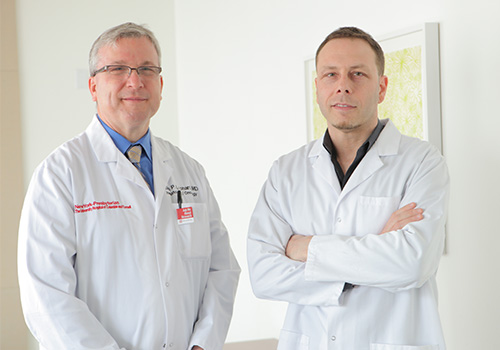Microenvironmental Signatures: What They Mean for B-Cell Lymphoma
Important strides made in the understanding of the pathogenesis of diffuse large B-cell lymphoma (DLBCL) over the past few years have facilitated improved therapeutics. However, the role of the microenvironment in this biologically and clinically heterogeneous disease is still poorly understood.
“The lymphoma microenvironment is essentially another layer of lymphoma biology that we believe we can use for classifying patients more accurately and potentially treating them more effectively,” says Leandro Cerchietti, MD, Associate Professor of Medicine in the Division of Hematology and Medical Oncology and member of the Weill Cornell Medicine Meyer Cancer Center in partnership with NewYork-Presbyterian Hospital. “The prognosis depends on the type of lymphoma, but for the broad category of non-Hodgkin lymphoma, the five-year survival rate is about 70 percent. The most common type of non-Hodgkin lymphoma is diffuse large B-cell lymphoma.”
Improvements in survival and cure rates for lymphoma patients now come from more targeted treatments based on detailed classifications of lymphomas according to DNA mutations and other properties of lymphoma cells themselves. With this in mind, the researchers sought to define the microenvironment’s role in DLBCL biology.
By analyzing the patterns of gene activity in tumor samples taken from the lymph nodes of more than 4,600 lymphoma patients, they found that the cells within these tumors – both healthy and cancer cells – produce molecules that collectively constitute a distinct microenvironment for the tumors, influencing their biology and growth.

Dr. John P. Leonard and Dr. Leandro Cerchietti
The new approach by Dr. Cerchietti and his Weill Cornell Medicine colleagues, including John P. Leonard, MD, Senior Associate Dean for Innovation and Initiatives and an internationally recognized expert on hematological malignancies, and Giorgio Inghirami, MD, a hematopathologist and Professor of Pathology and Laboratory Medicine, looks beyond lymphoma cells to the molecules surrounding them and the gene activity in lymphoma and non-lymphoma cells that helps maintain that molecular microenvironment.
In their findings, published in the June 2021 issue of Cancer Discovery, the authors describe four major lymphoma microenvironment categories that associate with distinct biological aberrations and clinical behavior ranging from tumor growth-restricting to tumor-growth enhancing. They also found:
- Evidence of genetic and epigenetic mechanisms deployed by cancer cells to evade microenvironmental constraints of lymphoma growth, supporting the rationale for implementing DNA hypomethylating agents in selected patients with DLBCL
- Lymphomas, in the course of the disease, even without new DNA mutation, tend to acquire the means to evade tumor-restrictive elements in their microenvironment and ultimately develop the capacity to modify their microenvironment, making it more cancer-permissive
“Our study showed that the environment surrounding the cancerous cells of a lymphoma tumor has a strong influence on the progression of these blood-cell cancers and their responses to therapies,” says Dr. Cerchietti. “We also demonstrated in an animal model that by experimentally modifying the lymphoma microenvironment we could slow the cancer’s growth. We observed that certain molecules called proteoglycans are closely associated with more restrictive microenvironments. In a proof-of-principle experiment, we found that boosting levels of these molecules significantly slowed lymphoma growth.”
“Measuring the molecular and cellular environment of lymphomas may represent a new type of precision medicine approach to lymphoma classification and treatment,” adds Dr. Cerchietti. “Characterizing the microenvironment as a critical component of B-cell lymphoma biology and associating it with DLBCL clinical behavior has created a novel opportunity for targeting therapies.”
Uncovering a Potential Cause of B-Cell Malignancies
A new study by researchers at Columbia University Vagelos College of Physicians and Surgeons indicates that errors in the way chromosomes are packed into antibody-producing B cells appear to play a role in the development of B-cell-related blood cancers.
Antibodies are made by B cells through a series of carefully controlled chromosome rearrangements and “good” mutations that allow the cell to make a wide array of different antibodies. “Although these changes are essential for generating the vast diversity of antibodies, there is a risk that ‘bad’ mutations will occur and lead to B-cell-derived cancers,” says study leader Uttiya Basu, PhD, Professor of Microbiology and Immunology at Columbia University.

Dr. Uttiya Basu
Dr. Basu’s new study in mice shows that the protein DIS3 is critical in maintaining genomic architecture and preventing uncontrolled chromosome rearrangements that have the potential to cause cancer. When DIS3 is missing, the B cells become destabilized, have more detrimental chromosomal rearrangements, and are less capable of generating specific antibodies. DIS3 stabilizes chromosomes by preventing the buildup of noncoding RNAs.
“The massive accumulation of these RNAs perturbs the way the genome is packed in the nucleus and leaves the genome vulnerable to DNA translocations,” explains Dr. Basu.
The findings of the study, published online February 1, 2021 in Nature Genetics, could lead to the identification of new biomarkers for predicting the onset of these cancers and to a new class of cancer therapies that prevents or corrects harmful changes in the genomic architecture.
“It’s possible that B-cell cancer treatment could require therapeutic interventions that prevent RNA accumulation and its effect on genome architecture,” says Dr. Basu. Future studies will focus on how architectural changes in the genome could be used to predict the onset of various B-cell malignancies, which sometimes begin as relatively benign conditions.


